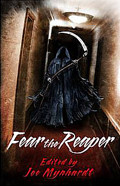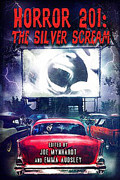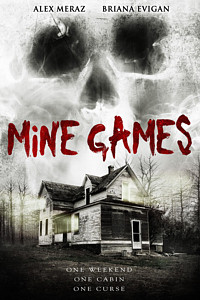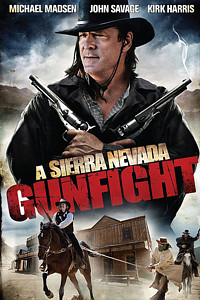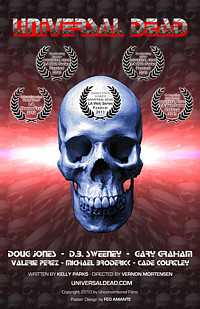| FEO FEED BACK? NEWS? SUBMISSIONS? Read: SUBMISSION GUIDELINES |
| MOVIES |
| FEO AMANTE THEATER |
| My Short Films LAST CALL THE NIGHT MY MONSTER DIED |
| SCIENCE MOMENT |
| TOP TEN SCARY MOVIES |
| UNFAIR RACIAL CLICHÉ ALERT |
| RACIAL CLICHÉ RESPONSE |
| INTERVIEWS |
| STORY TIME |
| COMICS |
| CONS |
| HORRIBLE NEWS |
 |
 |
Review by Mike Bracken |
||
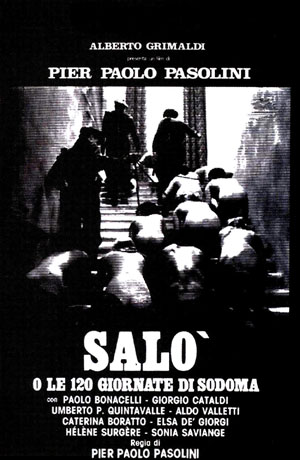
USA Release: Oct. 3, 1977 United Artists Rating: Australia: BANNED / Italy: VM18 / UK: BANNED / USA: Unrated |
||||
"There
is nothing either fundamentally good, nor anything fundamentally evil;
everything is relative, relative to our point of view . . . This point
once established,
it is extremely possible that something, perfectly indifferent in itself,
may be indeed
distasteful in your eyes, but may be most delicious in mine; and immediately
I
find it pleasing, immediately I find it amusing, regardless of our inability
to agree
in assigning a character to it, should I not be a fool to deprive myself
of it merely
because you condemn it?
- The Marquis de Sade from The 120 Days of Sodom
I chose to open this review with the above quote not only because it's from Sade's The 120 Days of Sodom, the very book that served as the basis for the Pier Pasolini film we're about to discuss, but also because it serves as perhaps the only logical defense for a film that's as disturbing, reprehensible, and morally bankrupt as SALO: The 120 Days of Sodom. Like Sade's infamous novel (which was written on a long roll of paper while he was imprisoned in the Bastille and never published during his lifetime) Pasolini's film is a nihilistically bleak look into the heart of man. And while on the surface, it seems to have little to no redeeming value whatsoever, in actuality it's a complex film that examines not only the darkness within us, but also our own passivity that allows tyrants like those featured in the film and novel to commit their atrocities. Still, in spite of these lofty artistic aspirations, many have chosen to dismiss the film as little more than elaborately filmed exploitation and condemn those who champion it - and it is to those critics that I offer the divine Marquis' thoughts on the matter.
Drawing on Sade's source material, but updating it and making it his own, Pasolini's (MEDEA, THE CANTERBURY TALES) SALO is the story of four aristocratic noblemen during World War II. These four individuals: the Duc, the President, the Bishop, and the Magistrate, conceive an elaborate plan to kidnap eighteen teenagers and abscond with them to an isolated mountain retreat, taking along their own daughters (who the four main characters have swapped and taken as wives), an entourage of guards, and four prostitutes.
Once there, they will spend the next 120 days listening to stories from the prostitutes. Each prostitute has a different specialty — one tells of simple sexual passions, another tells more outré sexual fare (i.e. coprophilia, etc.), yet another tells tales of torture, and so on. Each libertine has a small entourage, which he can use as he pleases as the stories fan the flames of his desires. What ensues is a nightmarish vision of subjugation, degradation, and destruction of the human spirit as the four libertines continually assault their captives in order to procure their own pleasure.
The film's performances are diverse and quite interesting. Most of the cast was comprised of people with no prior acting experience. This makes for an intriguing visual juxtaposition, particularly in the film's teen characters. These untrained actors are tabula razas throughout most of the film - never quite emoting anything despite the severity of their situation. In a different film, this might have been a hindrance, but since Pasolini's making a statement on the nature of apathy and fascism, it actually strengthens the movie.
Equally impressive are the four "heroes" of the film. Paolo Bonacelli (THE STENDHAL SYNDROME) turns in a particularly fine performance as the Duc. He's menacing and intriguing, often in the same scene. Giorgio Cataldi, Umberto Quintavalle, and Aldo Valletti (who play the Bishop, the President, and the Magistrate respectively) turn in solid performances as well - leering and delighting in the atrocities that they're perpetrating throughout the film.
Pasolini's direction is inspired. Much of the film is shot in a very static fashion - with a camera in a set position recording the events in the room with little or no movement. It gives the proceedings a documentary style feel that makes the film even more disturbing. Pasolini also manages to build tension throughout the movie: from the film's opening segment, "The Circle of Obsessions" onto the disturbing "Circle of Shit" and concluding with the orgy of murders in the "Circle of Blood", Pasolini continually keeps the atrocity level rising ever higher - even when it seems that things can get no worse, they do.
The film's certainly not for the squeamish or the easily offended. In SALO, rape and sodomy are fairly pedestrian peccadilloes. Viewers are treated to a multitude of perversions, including feces eating, bloodletting, scalpings, and finally brutal murder. This film is guaranteed to gross out even the most hardcore of viewers at some point.
Gruesome subject matter aside, Pasolini has a point. Much of the film's gore and violence is filmed at a distance, or takes place slightly offscreen, which allows the viewer to imagine events even worse than Pasolini could have filmed. When the film finally reaches the violent murders of its final act, the Duc watches the slaughter from a room above the killing fields, viewing it through binoculars - distancing himself from what gives him pleasure, but still delighting in it nonetheless. Pasolini also makes it fairly clear that he's indicting his audience and their passivity in watching this scene as well. The fact that these terrible acts are committed and viewed at a distance, without sound, makes them even more visceral and disturbing.
Surprisingly enough, the film is quite faithful to Sade’s five-hundred page novel until the final act. Many of the simple passions from the novel are recounted here, and it's only in the film's final act that Pasolini stakes out into territory that's solely his own.
Sadly, this would be the last film Pasolini would direct as a young male prostitute murdered him shortly after SALO's completion.
In the end, SALO: The 120 Days of Sodom is a powerful, visceral, disturbing film that looks into the darkest corners of the human psyche and never flinches from what it uncovers. Yes, it's exploitative, but it's also an artistic film made by a filmmaker who wanted to confront the complacency of both mainstream cinema as well as humankind. Few can look back on Sade's novel or Pasolini's film with fond memories, but even fewer would admit to not being affected by their savage vision. It is for this reason that anyone who's serious about film should see SALO: The 120 Days of Sodom. I give it nothing less than my highest recommendation.





This
review copyright 2000 E.C.McMullen Jr.
| SALO | |
| BLU-RAY | |

|
E.C. McMullen Jr. is a participant in the Amazon Services LLC Associates Program, an affiliate advertising program designed to provide a means for sites to earn advertising fees by advertising and linking to amazon.com.
| LOVE THIS SITE? KEEP IT GOING WHEN YOU BUY MY STUFF! |
|
| FEO AMANTE'S HORROR THRILLER Created by: E.C.MULLEN JR. |
| COME FOLLOW ME - AMAZON BLOG DEVIANT ART ECMJR IMDB PANDORA ROTTEN TOMATOES STAGE32 YOUTUBE ZAZZLE SHOP |
LOVE THIS SITE? E.C. McMullen Jr. HORROR 201: The Silver Scream Extensively quoted in Dept. head |




